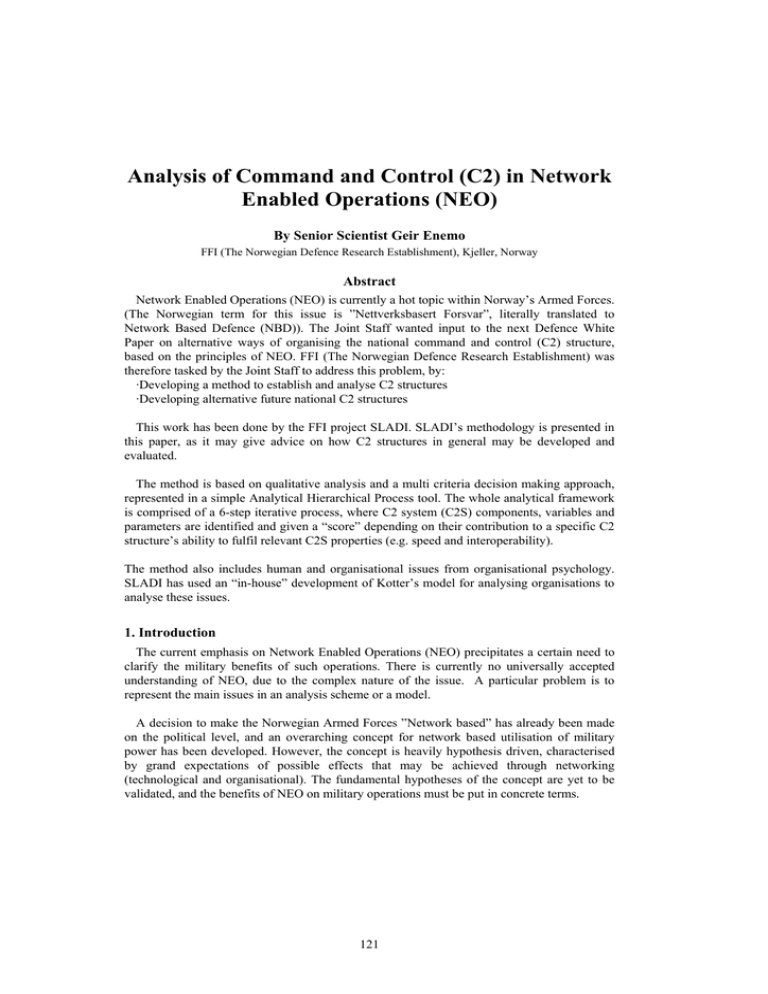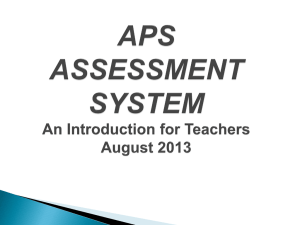in Network Enabled Operations
advertisement

Analysis of Command and Control (C2) in Network Enabled Operations (NEO) By Senior Scientist Geir Enemo FFI (The Norwegian Defence Research Establishment), Kjeller, Norway Abstract Network Enabled Operations (NEO) is currently a hot topic within Norway’s Armed Forces. (The Norwegian term for this issue is ”Nettverksbasert Forsvar”, literally translated to Network Based Defence (NBD)). The Joint Staff wanted input to the next Defence White Paper on alternative ways of organising the national command and control (C2) structure, based on the principles of NEO. FFI (The Norwegian Defence Research Establishment) was therefore tasked by the Joint Staff to address this problem, by: ·Developing a method to establish and analyse C2 structures ·Developing alternative future national C2 structures This work has been done by the FFI project SLADI. SLADI’s methodology is presented in this paper, as it may give advice on how C2 structures in general may be developed and evaluated. The method is based on qualitative analysis and a multi criteria decision making approach, represented in a simple Analytical Hierarchical Process tool. The whole analytical framework is comprised of a 6-step iterative process, where C2 system (C2S) components, variables and parameters are identified and given a “score” depending on their contribution to a specific C2 structure’s ability to fulfil relevant C2S properties (e.g. speed and interoperability). The method also includes human and organisational issues from organisational psychology. SLADI has used an “in-house” development of Kotter’s model for analysing organisations to analyse these issues. 1. Introduction The current emphasis on Network Enabled Operations (NEO) precipitates a certain need to clarify the military benefits of such operations. There is currently no universally accepted understanding of NEO, due to the complex nature of the issue. A particular problem is to represent the main issues in an analysis scheme or a model. A decision to make the Norwegian Armed Forces ”Network based” has already been made on the political level, and an overarching concept for network based utilisation of military power has been developed. However, the concept is heavily hypothesis driven, characterised by grand expectations of possible effects that may be achieved through networking (technological and organisational). The fundamental hypotheses of the concept are yet to be validated, and the benefits of NEO on military operations must be put in concrete terms. 121 2. Methodology - overview The methodology of project SLADI can be visualized in two ways. Figure 1 shows how several C2S properties are used as a starting point in the design and analysis of a C2 structure. I f C2 concept Kommandokonsept i t i l l i i / i Situational Speed Robustness and SituasjonsAwareness - Kommandosystemets Fleksibilitet sustainability forståelse t i i egenskaper C2S properties Beslutnings Decision Making dyktighet Hurtighet Interoperability Interoperabilitet ability Robusthet og utholdenhet Flexibility Design og analyseprosessen Design and analysis Dynam isk Beslut nin gsst øt te kom po nen t Beslut nin gskom po nen t Sam handli ngs kom po nen t Forvar ets oppgaver Infor masjo nsi nfrastruktur Sensor kom po nen t Effektor kom po nen t Oppgave 1 .... Oppgave6 Egens kap 1 .... Egens kap 6 C2 structures Kommandostrukturer FIGURE 1. SLADI methodology - 1. The process of design and analysis involves several tools (each illustrated by an icon in Figure 1): -a structural model -a model for structural analysis -a cost database -a multi-criteria decision making tool The second way of visualizing the methodology is shown in figure 2. Here, the iterative process of the methodology is shown more clearly. The same icons as in figure 1 are used for illustrating the different tools used in the different stages of the process. Justering Adjustments Justering Egenskaper C2S properties Egenskaper Dynam isk Beslut nin gsst øt te kom po nen t Kostnadsbetraktninger Cost consideration Kostnadsbetraktninger Beslut nin gs kom po nen t Infor Informasjo masjonsi nsinfrastruktur nfrastruktur Sensor kom po nen t Benefit Nyttebetraktninger consideration Nyttebetraktninger struktur structure vsegenskaper properties strukturvs vs egenskaper Grovskisser Sketches Grovskisser Effektor kom po nen t Variables Variabler and Variablerog og parametere parameters parametere Forvar ets oppgaver Oppgave 1 .... Oppgave6 Egens kap 1 .... Egens kap 6 Beskrivelse Detailed av Beskrivelse av kommandostrukturene C2 structures kommandostrukturene Sam handli ngs kom po nen t Prosess Nyttebetraktninger Benefit consideration Nyttebetraktninger parameters parametere egenskaper parametere vs vsproperties egenskaper FIGURE 2. SLADI methodology - 2. On the following pages, all elements in figures 1 and 2 will be explained in more detail, except the cost database. The database is an important part of the evaluation of C2 structures, but the methodological challenges in building the database are trivial compared to the other issues considered in this paper. 3. C2S properties The six C2S properties used in SLADI were defined in a conceptual work by the Norwegian Defence College called “C2 concept for Network Based Defence” (FSJ MFU 03 (2003)). Project SLADI was an active participant in the working group authoring the C2 concept. The naming of the six C2S properties are intended to be as self-explanatory as possible, but the issues involved are so complex that a more lengthy description is necessary for analysis purposes. In addition, project SLADI has developed a set of sub-properties: a second, more detailed level of properties to enhance the resolution of the methodology. However, for the purpose of this paper, this detailed description of properties and sub-properties is not needed, and it is therefore omitted. The six C2S properties are: -Situational Awareness -Decision Making (DM) ability -Speed (of DM process) -Interoperability -Robustness and sustainability -Flexibility 4. Structural model Studies of NEO require a change in the current analytical, conceptual and mental framework. Therefore, project SLADI developed a new structural model for describing a C2 structure. This model was inspired by software development, with components meshed by an all-encompassing information grid, or information infrastructure (INI). The INI connects all participants in the net. For analytical purposes (especially on cost issues) the INI can be divided into a communication infrastructure and a service infrastructure. Figure 3 shows a schematic of the structural model. BeslutningsstøtteDecision support komponent component BeslutningsDecision komponent component SamhandlingsLiaison component komponent Information infrastructure (INI) Informasjonsinfrastruktur SensorSensor component komponent 123 EffektorEffector component komponent FIGURE 3. Structural model used in SLADI. The important benefits of the structural model are: -It is recursive, i.e. it can be applied to all levels of an organisation -It is “neutral”, i.e. it does not imply pre-defined military or civilian organisational components (a typical example is the three services air, navy and army generally used in military organisations of today) -It does not imply any pre-defined hierarchy, i.e. it does not constrain the chain of command in a pre-defined way The structural model is used first as a tool to define rough sketches of different C2 structures. The sketches give overall ideas of how specific C2 structures could look like. Then, based on these sketches, more detailed C2 structures are developed. 5. Model for structural analysis (UPTO) The model for structural analysis (UPTO) is a FFI “in-house” development of Kotter’s model for analysing organisations (Kotter (1978)). The UPTO model uses five different perspectives from which to view the problem: two “structural” perspectives (“Technology” and “C2 organisation”) and three “non-structural” perspectives (“Individual”, “Internal social context” and “External context”). An outline of the model is shown in figure 4. Individual Internal social context (culture) Technology C2Processes External context C2-organization (formal structure) FIGURE 4. The UPTO model developed by SLADI. Each of the perspectives are defined by a set of C2S variables. Values for the variables are represented by a number of specific C2S parameters (for instance, the C2S variable “Depth of hierarchy” is represented by the C2S parameters “Deep” and “Flat”) The UPTO model contains a total of 23 structural and 32 non-structural C2S variables. The C2S variables (or more correctly, the associated C2S parameters) are “building blocks” out of which a specific (unique) C2 structure can be constructed. Strictly speaking, only the 122 structural C2S variables are used to define the tangible part of the C2 structure. The nonstructural variables are used to describe preconditions for a given C2 structure to function properly, or to point to both desirable and non-desirable effects if a specific C2 structure is put into action. 6. Method for Multi Criteria Analysis For benefit considerations of the C2 structures, SLADI has used a method for Multi Criteria Analysis called Analytical Hierarchical Process (AHP). The first step in this process is to construct a two-dimensional matrix with the structural C2S variables along one axis and the (C2S) sub-properties along the second. Each element in this matrix represents a relationship between a given variable (and its parameters) and a given sub-property. The total matrix should therefore represent all relationships between the building blocks of the C2 structure and the C2S properties, provided that all variables and all properties are orthogonal (there should be no interrelations between the different variables and between the different properties) In reality, this is not the case. The problem is far too complex and multi-faceted to be represented in a simple one-to-one relationship of a two-dimensional matrix, at least without a thorough investigation. SLADI has therefore emphasised an iterative approach, where variables, parameters and sub-properties are continuously evaluated in order to avoid inconsistencies between the parameters chosen for a specific C2 structure. Important tools in that regard are the nonstructural variables and parameters that, as mentioned before, are used to describe preconditions for a given C2 structure to function properly, or to point out the effects (both desirable and non-desirable) given that a specific C2 structure is put into action. A schematic view of this approach is shown in figure 5. Non-S tructural perspective s (analysi s) Individual C2-design Internal social context (Culture) Technology K2Prose ss Structural perspective s (design) Eksternal context C2-organization (formal structure) Non-S tructural perspective s (analysi s) FIGURE 5. A schematic view of the iterative approach used by SLADI. 123 C2-evaluation 6.1 Benefit considerations: C2S variables (parameters) vs. C2S sub-properties – critical relationships All the elements in the two-dimensional matrix (in other words, all relationships between variables and sub-properties) should in theory be evaluated either quantitatively or qualitatively. In this case, this would result in more than 400 different issues to be addressed. However, all issues are not considered to be of equal importance. “Critical relationships” were identified, analysed and evaluated in close cooperation with experienced military personnel. Each “critical relationship” was evaluated in terms of how the variable’s parameters effect a given sub-property. These evaluations resulted in a three-level grading of the relationships: -Low: The parameter does not affect the given sub-property in a positive way -High: The parameter affects the given sub-property in a positive way -Very high: The parameter affects the given sub-property in a very positive way As an example, the variable “hierarchy” with the parameters “flat” and “deep” was evaluated against the sub-property “speed: distribution of information”. The parameter “deep” hierarchy was found not to have a positive effect on the speed of information distribution, and subsequently the evaluation result was “Low”. 6.2 Benefit considerations: C2 structures vs. C2S properties Specific C2 structures are constructed by choosing a parameter for each structural variable. The non-structural variables are used to avoid inconsistencies in a given C2 structure. Therefore, the non-structural variables and parameters are not directly fed into the AHP methodology. Instead, they are used to evaluate the feasibility of the different C2 structures made by the project. When a C2 structure is defined through chosen parameters, every parameter will be represented by the previously mentioned grades of “Low”, “High” and “Very high” in relation to the different sub-properties. Each sub-property is then given a value (“score”), calculated as the arithmetic average of all chosen parameters. 6.3 Aggregation of results in an analytical hierarchy The analytical hierarchy consists of three levels, with the end result being a score representing how well a given C2 structure performs over the entire spectrum of different tasks (see figure 6). This score is only used to help the analyst rank the different C2 structures. It does not give an answer in absolute terms of how much better one C2 structure is compared to another. 124 Quality of information Task 1 Situational Awareness Availability of information Decision Making ability Cognitive ability Task 2 Speed DM process Task 3 Total benefit Interoperability Task 4 Robustness and sustainability Task 5 Flexibility Task 6 Other tasks FIGURE 6. The analytical hierarchy. The score for each sub-property is aggregated into a total score for each property. The different properties are given different weights, varying with the task. As an example, “Interoperability” is considered to be more important in tasks related to coalition activities than tasks concerning day-to-day operations in national territorial waters. Finally, based on a weighting of the different tasks, a number representing the performance of the C2 structure is found. Project SLADI used a commercially available tool, Expert Choice, to organize and visualize the process. The graphical representation of the score of a specific C2 structure for each C2S property is called the “C2S property profile”. An example of 3 such profiles is shown in figure 7. 125 Structure F Structure D Flexibility C2S property profiles for C2 structures D, E and F. Robustness and survivability sustainability Interoperability Speed DM process making capability ability Decision Making Situational awareness Awareness Structure E 7. Summary of the SLADI methodology The SLADI methodology is an iterative, evolutionary methodology. Each iteration starts with a close look at C2S properties and sub-properties. Based on lessons learned from previous iterations, an assessment is made whether an adjustment is needed for definitions, sub-properties or weighting of properties in the different tasks. The next step is to adjust or make new rough sketches of C2 structures. This gives the opportunity to incorporate changes since last iterations, typically in force structures and/or political constraints. The UPTO model is then used to check the validity of the structural and non-structural variables. At this point the two axes in the relationship matrix are defined, and the critical relationships are identified and evaluated. Specific C2 structures are assembled and checked for inconsistencies with the UPTO model. Finally, the results are put into the AHP tool Expert Choice and the C2S property profiles are plotted. REFERENCES FORSVARSSJEFENS MILITÆRFAGLIGE UTREDNING 2003 (FSJ MFU 03). 2003. Kommandokonsept i Nettverksbasert Forsvar – Grunnlag. KOTTER, J.P. 1978. Organizational dynamics: diagnosis and intervention. Adisson-Wesley Publishing Company. 126








